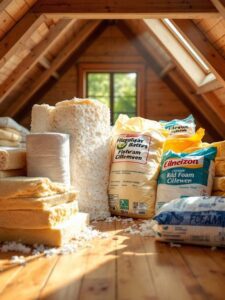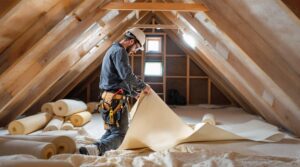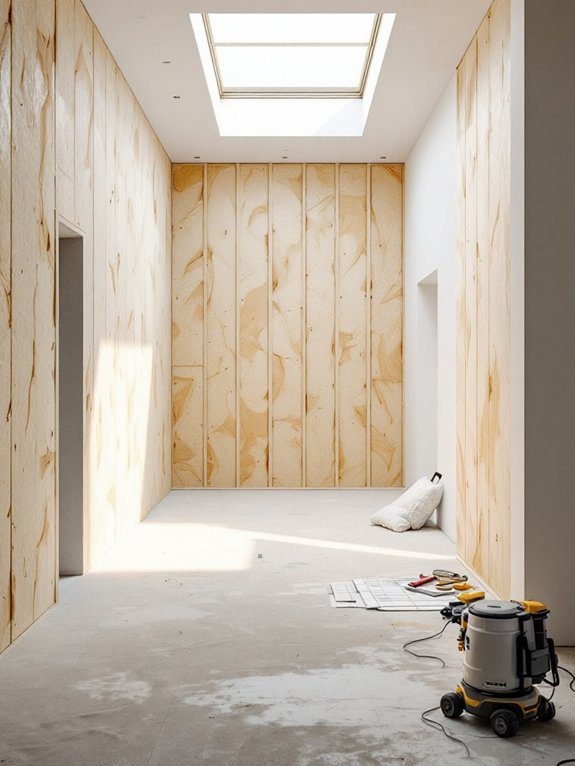You’ll find UK loft insulation costs range from £650-£2,000 for professional installation, while DIY options can save up to 60%. Material prices vary markedly: fibreglass blanket costs £10/m², mineral wool £13-17.5/m², and PIR foam board £30/m². Labour rates typically run £150-£400 daily. With potential annual savings of £445 and government grants available through ECO4 and GBIS schemes, your investment could pay for itself within 2-3 years. The following analysis breaks down your best cost-saving options.
Key Takeaways
- Professional loft insulation costs range from £650-£2,000, with DIY installation saving up to 60% on total expenses.
- Material costs vary significantly: fibreglass (£10/m²), mineral wool (£13-17.5/m²), and premium options like spray foam (£35-50/m²).
- Professional installation labor rates average £250 per day, with most installations completed within one day.
- Government schemes like ECO4 and GBIS offer financial support, with complete coverage available for qualifying homeowners.
- Investment of £1,200 can yield £445 annual savings, with payback within 2-3 years and benefits lasting up to 40 years.
Understanding Different Loft Insulation Materials and Their Costs

When choosing loft insulation, understanding the cost variations between different materials can greatly impact your budget and long-term energy savings.
Among popular insulation types, fibreglass blanket offers the most budget-friendly option at £10 per m², while loose-fill alternatives range from £7.50 to £12 per m². Cellulose insulation provides excellent coverage by filling gaps and voids effectively.
Your material comparisons should factor in both cost and performance. Professional installation typically costs around £250 per day for any material type.
Mineral wool insulation presents a mid-range choice at £13-17.5 per m², offering good thermal efficiency.
If you’re prioritizing eco-friendly solutions, sheep wool insulation costs between £17.5-22 per m².
For loft conversions, PIR foam board at £30 per m² provides excellent thermal properties.
The premium option, spray foam insulation, ranges from £35-50 per m², delivering superior sealing but requiring professional installation.
Labour Costs and Installation Expenses Breakdown
Understanding the labour costs of loft insulation requires careful consideration of several key variables, with daily rates typically ranging from £150 to £400 across the UK.
You’ll find that installation types markedly impact your total costs, with professional installations ensuring both compliance and labour efficiency.
When planning your budget, factor in that most installations take less than a day, though you might need additional time for specialised tasks.
Basic materials like fiberglass insulation costs typically start from £10 per square meter in the UK market.
If you’re in urban areas like London, expect to pay premium rates compared to rural locations.
You’ll also need to account for potential extra labour charges, such as £250-£300 per day for electrical wire relocation.
Post-installation boarding costs for creating usable storage space average £55 per m² for most loft spaces.
Cost Comparison: Professional Vs DIY Installation

Though professional loft insulation typically costs between £650-£2,000, DIY installation can reduce expenses by up to 60% through eliminated labor costs.
When weighing your options, consider these key factors that influence the final price and overall value:
- Professional advantages include expert installation, warranties, and guaranteed compliance with building regulations, though you’ll pay around £250 per day for labor.
- DIY challenges involve significant time investment and potential risks from improper installation, but you’ll only pay £5-£50 per square meter for materials.
- Your choice should factor in loft size, material type, and accessibility – larger or complex spaces might justify professional costs, while straightforward installations suit DIY.
Professional installation includes high-quality materials and expert knowledge that can maximize long-term energy savings.
Your decision ultimately depends on your skills, budget, and time availability. Installing blanket insulation typically takes 2-6 hours for professionals to complete.
Making the right choice between DIY and professional installation comes down to balancing your abilities, finances, and available time.
Remember that incorrect DIY installation can reduce energy efficiency and increase long-term costs.
Government Grants and Financial Support Options
Looking to reduce your loft insulation costs? Several government grants and financial assistance programs can help you upgrade your home’s insulation at little to no cost.
The ECO4 scheme and Great British Insulation Scheme (GBIS) offer substantial support for eligible households. High-quality materials like mineral wool insulation can provide effective home protection for up to 100 years with proper maintenance.
Your grant eligibility typically depends on your income, property’s EPC rating, and council tax band. Local authorities can now set their own criteria through LA Flex provisions. If you’re receiving Universal Credit or Pension Guarantee Credit, you’ll likely qualify for additional support.
Properties with EPC ratings of D or lower in council tax bands A-D (England) or A-E (Scotland) are prime candidates for assistance.
From spring 2025, the new Warm Homes Plan will provide up to £15,000 for energy improvements.
These schemes can help you save up to 25% on energy bills while contributing to the UK’s sustainability goals.
Long-Term Savings and Return on Investment

The significant financial benefits of loft insulation make it one of the most cost-effective home improvements available. Using a savings calculator, you’ll find that your initial investment of £1,200 for a detached house can yield annual returns of up to £445. Installing 270mm of insulation ensures maximum energy efficiency for your property.
Quilt insulation materials start at just £10 per square metre, making it an accessible option for most homeowners.
With a payback period of just 2-3 years, you’re making a smart financial decision that’ll benefit your home for decades.
- Your investment will last up to 40 years, delivering consistent energy savings throughout its lifespan.
- You’ll reduce your energy bills by up to 25% while increasing your property’s market value.
- Your home’s EPC rating will improve, potentially increasing property value by up to 14%.
The investment benefits extend beyond immediate savings, creating a more sustainable and valuable property while contributing to collective environmental goals.
Factors Affecting Total Insulation Costs
When choosing loft insulation, several key factors greatly influence your total project costs. The type of insulation material you select creates considerable price variations, from £10 per m² for standard blanket insulation to £37 per m² for spray foam options.
Your loft’s accessibility and complexity directly impact labor costs, which typically range from £250 to £450 daily.
The insulation thickness you’ll need depends on your local climate impact and existing home efficiency. You’ll also need to take into account additional expenses like electrical rewiring (around £250 per day) and pipework insulation (£6-£35 per metre).
If you’re planning to use your loft for storage, factor in boarding costs at approximately £55 per m².
Mineral wool insulation offers superior soundproofing and fire resistance, making it an excellent choice for homes in noise-sensitive areas despite its higher cost.
Regional Price Variations Across the UK

Across the UK’s diverse regions, loft insulation costs fluctuate greatly based on local market conditions and installation challenges. Regional pricing trends show Northern Ireland typically commands higher rates, with detached homes costing £1,300-£1,700, while similar properties in England and Wales average around £1,200.
Loft insulation prices vary significantly across UK regions, with Northern Ireland seeing notably higher costs than England and Wales.
- Urban influence greatly impacts costs, with London’s prices being remarkably higher despite lower insulation rates.
- Professional installation fees vary by location, averaging £250 per day but fluctuating based on local labor markets.
- Government schemes like ECO4 help offset regional disparities, making insulation more accessible across different areas.
You’ll find the most cost-effective solutions by comparing local quotes and checking your eligibility for area-specific grants.
Understanding your region’s typical pricing range helps you make informed decisions while ensuring you’re getting competitive rates for your insulation project.
Homeowners with less than 100mm of insulation may qualify for complete coverage of installation costs through government-backed initiatives.
Material Quality and Performance Vs Price Analysis
Choosing ideal loft insulation materials requires careful analysis of quality metrics against cost factors. When you’re evaluating material performance, you’ll find that fibreglass and mineral wool both deliver thermal conductivity of 0.044 W/mK, while offering different price points and installation considerations. Knauf’s innovative ECOSE Technology helps reduce environmental impact through bio-based binding materials.
| Material | Performance Metrics | Cost Range |
|---|---|---|
| Fibreglass | Non-combustible (A1), 2.2-2.7 R-value | £20-£40/roll |
| Mineral Wool | Non-combustible, Fire resistant | £35-£57/roll |
| Sheep’s Wool | 3.5-3.8 R-value, Moisture adaptive | £45-£65/roll |
| Glass Wool | Similar to fibreglass, Better sound insulation | £25-£45/roll |
For ideal insulation longevity, you’ll want to take into account that while fibreglass offers the most cost-effective solution, sheep’s wool provides superior thermal performance. Your choice ultimately depends on balancing budget constraints with desired performance characteristics for your specific loft requirements.
Frequently Asked Questions
How Long Does the Loft Insulation Installation Process Typically Take?
Your loft insulation installation timeline typically spans 1-5 days, varying by insulation types you choose. While blanket and loose-fill installations take a few hours, more complex materials like boarding require up to 24 hours.
Can I Store Items in My Loft After Installing Insulation?
Like building a bridge over water, you’ll need raised loft boards with proper supports above your insulation. You can store items safely, but don’t place them directly on insulation—it’ll compress and reduce effectiveness.
Will Loft Insulation Affect My Home’s Resale Value?
Your home’s resale value will likely increase with loft insulation. Research shows 88% of buyers prioritize energy efficiency, making your property more appealing. You’ll join other forward-thinking homeowners who’ve enhanced their property’s marketability.
Do I Need to Remove Old Insulation Before Installing New Material?
Like peeling back layers of an onion, you’ll need to assess your old insulation first. Different insulation types and installation benefits may allow layering, but remove it if there’s damage, moisture, or health hazards.
How Often Should Loft Insulation Be Inspected or Replaced?
You’ll need to inspect your loft insulation every 5-7 years, with seasonal moisture checks between inspections. Most insulation types last 20-25 years when properly maintained, but replace sooner if you notice significant deterioration.
Conclusion
Why wait to start saving up to £580 annually on your energy bills? Professional loft insulation costs between £1,500-£2,500 for an average UK home, but you’ll recoup this investment within 2-4 years through reduced heating costs. With government grants covering up to 75% of expenses and DIY options available from £400, upgrading your loft insulation represents a data-proven solution for improving your home’s energy efficiency.
References
- https://www.theecoexperts.co.uk/insulation/best-loft-insulation
- https://www.checkatrade.com/blog/cost-guides/loft-insulation-cost/
- https://www.greenmatch.co.uk/insulation/loft/best
- https://www.theecoexperts.co.uk/insulation/loft-insulation-costs
- https://www.buyinsulationonline.co.uk/blog/which-loft-insulation-is-right-for-your-home
- https://whatcost.co.uk/insulation/loft/cost
- https://buildifyltd.co.uk/installing-loft-insulation-costs/
- https://hoa.org.uk/advice/guides-for-homeowners/i-am-improving/loft-insulation-costs/
- https://www.theloftboys.co.uk/lofts/loft-insulation/
- https://www.mybuilder.com/insulation/price-guides/loft-insulation-cost








